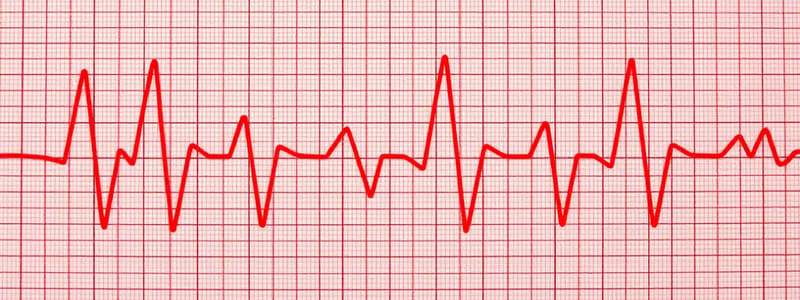Podcast
Questions and Answers
What defines tachycardia?
What defines tachycardia?
- A heart rate below 60 beats per minute
- A heart rate exceeding 100 beats per minute (correct)
- A heart rate that varies widely in rhythm
- A heart rate that maintains sinus rhythm only
Which of the following factors can contribute to sinus tachycardia?
Which of the following factors can contribute to sinus tachycardia?
- Increased body temperature (correct)
- Increased cardiac muscle size
- Vagal stimulation
- Regular physical exercise
Which condition often causes sinus bradycardia?
Which condition often causes sinus bradycardia?
- Chronic anxiety
- Hyperthyroidism
- Athletic conditioning (correct)
- Acute stress response
What differentiates tachycardia from bradycardia?
What differentiates tachycardia from bradycardia?
Which of the following statements about the sinus node is correct?
Which of the following statements about the sinus node is correct?
What physiological effect does sympathetic stimulation have on the heart?
What physiological effect does sympathetic stimulation have on the heart?
What type of response is vagal stimulation most commonly associated with?
What type of response is vagal stimulation most commonly associated with?
How does increased body temperature affect heart rate?
How does increased body temperature affect heart rate?
Flashcards are hidden until you start studying
Study Notes
Abnormal Sinus Rhythms
- Arrhythmias can stem from issues with the sinus node, shifts in pacemaker sites, conduction blocks, or abnormal conduction pathways.
- The sinus node serves as the natural pacemaker, sending signals to the AV node, which then transmits impulses through Purkinje fibers to the rest of the heart.
Tachycardia
- Tachycardia is defined as a heart rate exceeding 100 beats per minute.
- Sinus Tachycardia maintains a normal sinus rhythm without blocks or abnormal pathways, but the heart beats faster due to various factors.
- Primary causes of sinus tachycardia include:
- Increased Body Temperature: Each 1°C rise prompts about an 18 beats per minute increase in heart rate.
- Sympathetic Stimulation: Occurs during stress (fight or flight response), raising heart rate while maintaining sinus rhythm.
- Toxic Conditions of the Heart: Weakened cardiac muscle leads to reduced stroke volume, prompting the heart to compensate by increasing heart rate.
Bradycardia
- Bradycardia is characterized by a heart rate below 60 beats per minute.
- Sinus Bradycardia reflects a normal rhythm despite the reduced rate.
- Factors contributing to sinus bradycardia include:
- Athletic Conditioning: Increased heart muscle size leads to higher cardiac output; thus, the heart rate decreases to maintain normal output.
- Vagal Stimulation: Activated by the vagus nerve, usually after baroreceptor stimulation, results in slower heart rates due to acetylcholine release.
Key Differences
- Tachycardia entails a fast heart rate with normal rhythm, while bradycardia involves a slow heart rate still maintaining a normal sinus rhythm.
- Mechanisms for tachycardia primarily involve external physiological stressors, while bradycardia can relate to enhanced physical fitness or specific reflex responses.
Summary
- Abnormal sinus rhythms consist of tachycardia (heart rate >100) and bradycardia (heart rate <60).
- Both conditions can arise from physiological adaptations, responses to stimuli, or pathological states.
- Understanding these rhythms is crucial for diagnosing and managing arrhythmias effectively.
Abnormal Sinus Rhythms
- Arrhythmias arise from sinus node issues, altered pacemaker sites, conduction blocks, or abnormal conduction pathways.
- The sinus node is the heart's natural pacemaker, initiating signals that pass to the AV node, then spreading through Purkinje fibers throughout the heart.
Tachycardia
- Tachycardia is identified as a heart rate surpassing 100 beats per minute.
- Sinus Tachycardia keeps a normal rhythm despite an increased heart rate due to various physiological factors.
- Primary causes of sinus tachycardia include:
- Increased body temperature leads to an approximate 18 beats per minute rise for each 1°C increase.
- Sympathetic stimulation during stress elevates heart rate while retaining a normal sinus rhythm.
- Toxic heart conditions diminish stroke volume, causing the heart to speed up to maintain adequate blood circulation.
Bradycardia
- Bradycardia is characterized by a heart rate below 60 beats per minute.
- Sinus Bradycardia features a normal rhythm but with a slower heart rate.
- Contributing factors to sinus bradycardia include:
- Athletic conditioning results in larger heart muscle and increased cardiac output; the heart compensates by slowing the rate.
- Vagal stimulation occurs from the vagus nerve's activation and baroreceptor stimulation, slowing heart rates through acetylcholine release.
Key Differences
- Tachycardia involves a fast heart rate with a normal rhythm, whereas bradycardia represents a slow heart rate that still maintains a normal sinus rhythm.
- Mechanisms causing tachycardia are often related to external stressors, while bradycardia can be associated with physical fitness or specific reflex responses.
Summary
- Abnormal sinus rhythms are categorized mainly into tachycardia (heart rate exceeding 100 bpm) and bradycardia (heart rate below 60 bpm), both reflecting varying physiological conditions while maintaining normal sinus rhythms.
Studying That Suits You
Use AI to generate personalized quizzes and flashcards to suit your learning preferences.




